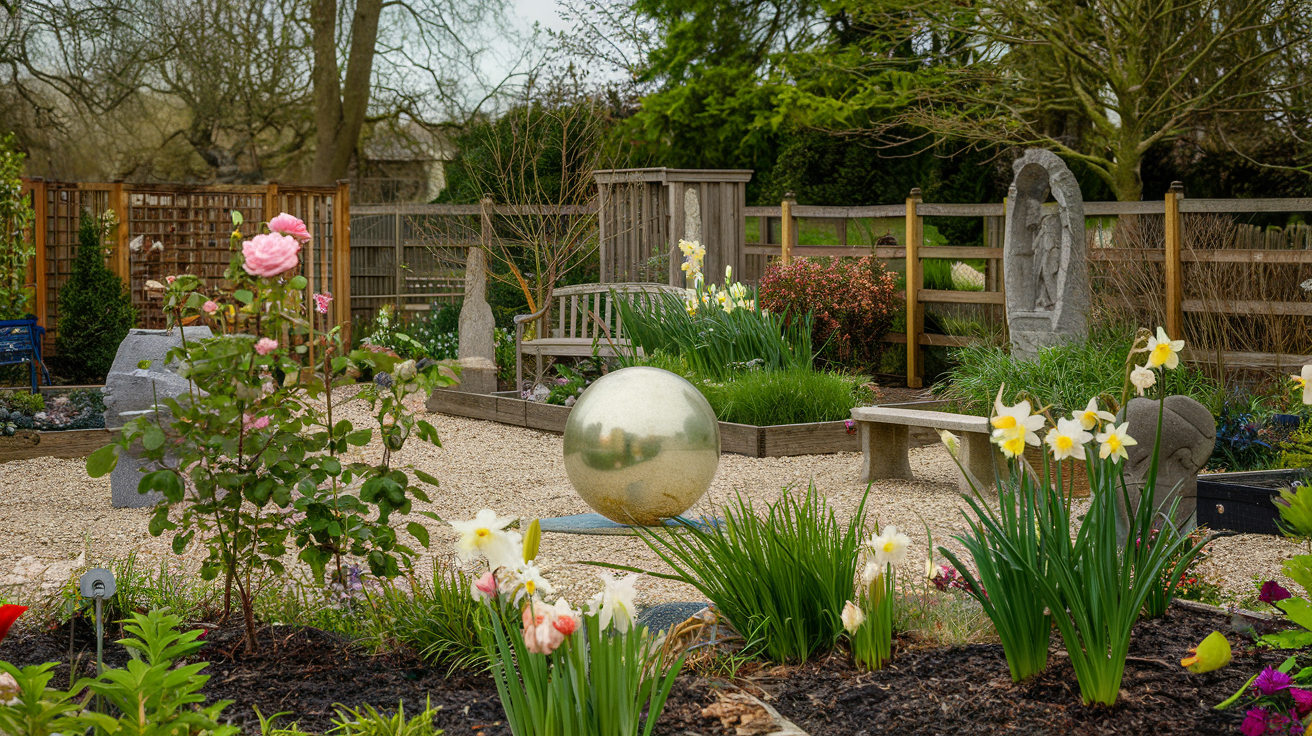Gazing balls have long been a favorite addition to gardens, bringing a touch of whimsy and elegance to outdoor spaces. Rhys Garden has discovered countless ways to incorporate these reflective spheres into garden designs. In this guide, I’ll share creative ideas for using gazing balls to enhance the beauty of your garden, whether you’re aiming for a modern, classic, or whimsical look.
What Are Gazing Balls and Their History in Gardens?
Gazing balls, also known as garden globes or mirror balls, are decorative spheres typically made of glass, metal, or ceramic. They’ve been gracing gardens since the 13th century, originating in Venice, Italy. King Ludwig II of Bavaria, famous for his extravagant tastes, popularized their use in garden design during the 19th century.
These shimmering orbs serve more than just an aesthetic purpose. They reflect and amplify light, creating a sense of depth and movement in your garden. This play of light can make small spaces appear larger and add interest to shady areas.
Choosing the Perfect Gazing Ball for Your Garden

When selecting a gazing ball, consider the following factors:
Material Matters
- Glass: Traditional and elegant, but fragile
- Stainless Steel: Durable and weather-resistant
- Ceramic: Offers unique patterns and colors
- Mosaic: Adds a artistic, handcrafted touch
Size and Proportion
The size of your gazing ball should complement your garden’s scale. A general rule of thumb is:
- Small gardens (under 100 sq ft): 6-8 inch diameter
- Medium gardens (100-500 sq ft): 10-12 inch diameter
- Large gardens (over 500 sq ft): 14-18 inch diameter
Color Coordination
Choose a color that either contrasts or complements your existing garden palette. Silver and blue are classic choices, while bold colors like red or purple can create striking focal points.
Creative Placement Ideas for Gazing Balls
The key to a stunning gazing ball display is thoughtful placement. Here are some ideas to inspire you:
Focal Point in a Flower Bed
Place a gazing ball at the center of a circular flower bed, surrounded by concentric rings of colorful blooms. This creates a mesmerizing bulls-eye effect, drawing the eye inward.
Reflecting Pool Companion
Position a gazing ball near a water feature to double the reflective impact. The interplay between the still water and the curved surface of the ball creates a captivating visual effect.
Path Illuminator
Line a garden path with smaller gazing balls to guide visitors through your landscape. This is particularly enchanting when lit at night.
Tree Base Accent
Nestle a gazing ball at the base of a tree, surrounded by shade-loving plants like hostas or ferns. This adds a magical touch to often overlooked areas.
Elevated Display
Mount gazing balls on pedestals or columns at varying heights to create a sculptural installation. This works well in formal garden designs.
DIY Gazing Ball Projects
For the crafty gardener, creating your own gazing ball can be a rewarding project. Here are two simple ideas:
Upcycled Bowling Ball Gazing Ball
Transform an old bowling ball into a unique garden ornament:
- Clean the bowling ball thoroughly
- Apply a coat of metallic spray paint
- Once dry, add a layer of clear sealant for weather protection
- Place in your garden and enjoy!
Mosaic Gazing Ball
Create a personalized mosaic gazing ball using:
- A styrofoam ball
- Mosaic tiles or broken china
- Tile adhesive and grout
- A clear sealant
This project allows for endless creativity in patterns and color combinations.
Maintaining Your Gazing Ball Garden
To keep your gazing balls looking their best:
- Clean regularly with mild soap and water
- Protect from extreme weather conditions
- Secure properly to prevent rolling or theft
- Consider bringing delicate balls indoors during harsh winters
Gazing Balls and Garden Wildlife
Interestingly, gazing balls can have an impact on garden wildlife:
Birds and Reflective Surfaces
Some birds may be attracted to their own reflection in gazing balls. While this can be entertaining, it’s important to monitor for any signs of stress in the birds.
Insect Behavior
The reflective surface of gazing balls can confuse some insects, potentially altering their behavior in your garden. This can be a natural way to deter certain pests.
Feng Shui and Gazing Balls
In Feng Shui philosophy, gazing balls are believed to:
- Deflect negative energy
- Attract positive chi (life force)
- Create a sense of calm and balance in the garden
Consider placing gazing balls in the wealth or health areas of your garden according to Feng Shui principles.
Seasonal Gazing Ball Displays
Adapt your gazing ball displays to the changing seasons:
Spring
Surround with spring bulbs like tulips and daffodils for a burst of color.
Summer
Create a tropical paradise with gazing balls nestled among vibrant annuals and lush foliage plants.
Fall
Complement the autumnal palette by placing gazing balls amidst ornamental grasses and late-blooming perennials.
Winter
Use gazing balls to add interest to evergreen plantings and create magical ice sculptures when temperatures drop.
Gazing Balls in Different Garden Styles
These versatile ornaments can enhance various garden styles:
Formal Gardens
In symmetrical layouts, use identical gazing balls to reinforce the sense of order and balance.
Cottage Gardens
Integrate whimsical, colorful gazing balls among the abundant, informal plantings typical of cottage gardens.
Japanese Gardens
Incorporate reflective gazing balls near water features or rock gardens to enhance the meditative atmosphere.
Modern Gardens
Use sleek, metallic gazing balls as sculptural elements in minimalist garden designs.
Lighting and Gazing Balls
Enhance the magic of your gazing ball garden after dark with strategic lighting:
Solar-Powered Spotlights
Place small solar spotlights around your gazing balls to create a enchanting nighttime display.
LED String Lights
Drape delicate LED string lights near gazing balls for a fairy-tale effect.
Color-Changing Lights
Use color-changing LED lights to transform the mood of your gazing ball display throughout the evening.
Gazing Balls and Water Conservation
Surprisingly, gazing balls can play a role in water-wise gardening:
- They reduce the need for water-hungry plants in key focal areas
- Their reflective surfaces can help distribute light to shaded areas, reducing the need for sun-loving, water-intensive plants
- When placed near drought-tolerant plants, they create visual interest without increasing water demands
Frequently Asked Questions About Gazing Ball Gardens
1. Are gazing balls safe for children and pets?
While generally safe, glass gazing balls can break if knocked over. Consider using shatterproof materials in areas frequented by children or pets.
2. How do I prevent my gazing ball from being stolen?
Use a gazing ball stand with a locking mechanism or create a DIY solution by securing the ball to a hidden stake in the ground.
3. Can gazing balls withstand freezing temperatures?
Glass and ceramic gazing balls may crack in freezing temperatures. It’s best to bring them indoors during harsh winters or choose weather-resistant materials.
4. How often should I clean my gazing balls?
Clean your gazing balls at least once a month, or more frequently if they’re under trees or in dusty areas. Regular cleaning ensures they maintain their reflective properties.
5. Can gazing balls be used indoors?
Absolutely! Gazing balls can make stunning indoor decorations, especially in sunrooms or near windows where they can catch and reflect natural light.
Conclusion
Incorporating gazing balls into your garden is a simple yet effective way to add visual interest and charm. With a variety of styles and placements to choose from, you can customize the look to perfectly complement your garden’s design. By experimenting with different ideas, you’ll find that gazing balls can transform your outdoor space into a captivating and serene retreat, reflecting the beauty of your garden in more ways than one.

Related Posts
Understanding Mounding Perennials: Nature’s Living Sculptures in Your Garden
The Ultimate Guide to Palm Tree Pruning Cost
The Ultimate Guide to Raised Garden Beds Against Fences